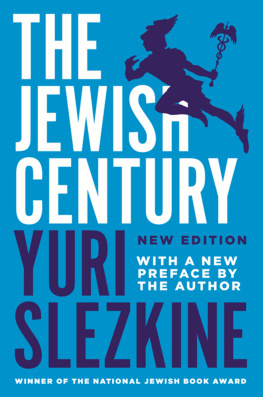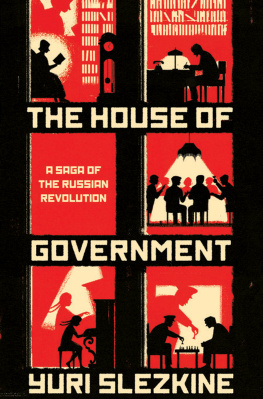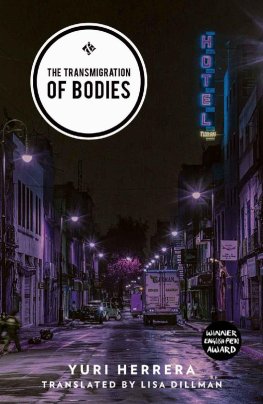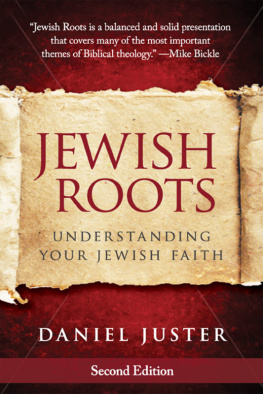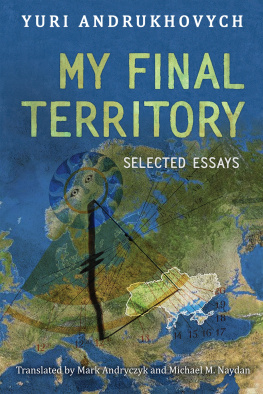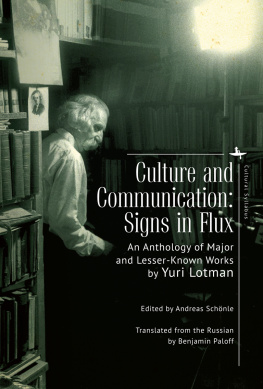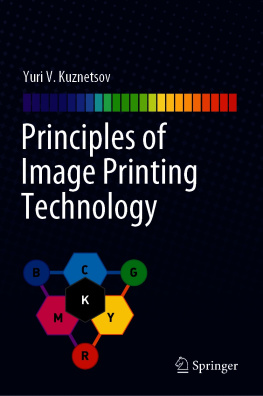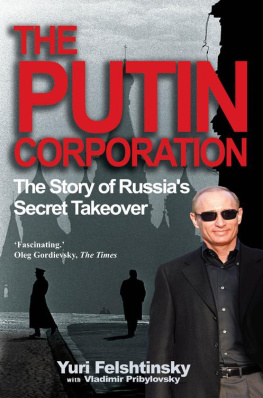Yuri Slezkine - The Jewish Century, New Edition
Here you can read online Yuri Slezkine - The Jewish Century, New Edition full text of the book (entire story) in english for free. Download pdf and epub, get meaning, cover and reviews about this ebook. year: 2019, publisher: Princeton University Press, genre: Home and family. Description of the work, (preface) as well as reviews are available. Best literature library LitArk.com created for fans of good reading and offers a wide selection of genres:
Romance novel
Science fiction
Adventure
Detective
Science
History
Home and family
Prose
Art
Politics
Computer
Non-fiction
Religion
Business
Children
Humor
Choose a favorite category and find really read worthwhile books. Enjoy immersion in the world of imagination, feel the emotions of the characters or learn something new for yourself, make an fascinating discovery.
- Book:The Jewish Century, New Edition
- Author:
- Publisher:Princeton University Press
- Genre:
- Year:2019
- Rating:5 / 5
- Favourites:Add to favourites
- Your mark:
- 100
- 1
- 2
- 3
- 4
- 5
The Jewish Century, New Edition: summary, description and annotation
We offer to read an annotation, description, summary or preface (depends on what the author of the book "The Jewish Century, New Edition" wrote himself). If you haven't found the necessary information about the book — write in the comments, we will try to find it.
The Jewish Century, New Edition — read online for free the complete book (whole text) full work
Below is the text of the book, divided by pages. System saving the place of the last page read, allows you to conveniently read the book "The Jewish Century, New Edition" online for free, without having to search again every time where you left off. Put a bookmark, and you can go to the page where you finished reading at any time.
Font size:
Interval:
Bookmark:

The Jewish Century

The Jewish Century

New Edition
With a new preface by the author
Yuri Slezkine
PRINCETON UNIVERSITY PRESS
PRINCETON AND OXFORD
Copyright 2004 by Princeton University Press
New edition, with a new preface by the author,
2019 by Princeton University Press
Published by Princeton University Press, 41 William Street,
Princeton, New Jersey 08540
In the United Kingdom: Princeton University Press,
6 Oxford Street, Woodstock, Oxfordshire OX20 1TR
Cover image courtesy of Shutterstock
All Rights Reserved
First published in 2004
First paperback printing, 2006
New paperback edition, with a new preface by the author, 2019
Paper ISBN: 978-0-691-19282-6
The Library of Congress has cataloged the cloth edition of this book as follows
Slezkine, Yuri, 1956
The Jewish century / Yuri Slezkine.
p.cm.
Includes bibliographical references and index.
ISBN 0-691-11995-3 (alk. paper)
1. JewsEuropeEconomic conditions. 2. JewsEuropeSocial conditions. 3. JewsRussiaEconomic conditions19th century. 4. JewsRussiaEconomic conditions20th century. 5. JewsRussiaSocial conditions19th century. 6. JewsRussiaSocial conditions20th century. 7. RussiaEthnic relations. 8. RussiaCivilizationJewish influences. 9. Civilization, ModernJewish influences. 10. Social integrationRussia. 11. CapitalismSocial aspects. 12. EntrepreneurshipSocial aspects. I. Title.
DS140.5.S592004
940.04924dc222003069322
British Library Cataloging-in-Publication Data is available
This book has been composed in Galliard text with Bodega Sans Display
Printed on acid-free paper.
press.princeton.edu
Printed in the United States of America
Contents

Preface to the 2019 Paperback Edition

I did not mean to write this book.
In 1994, I wrote an article called The Soviet Union as a Communal Apartment, in which communal apartment was a metaphor for the Soviet state as a multinational federation (with union republics occupying separate rooms while sharing the same kitchen and bathroom). Having exhausted the metaphor, I decided to write a history of an actual communal apartment, in which several families (such as my own, until I was fourteen) occupied separate rooms while sharing the same kitchen and bathroom. After several months of searching for an apartment with a long enough line of consecutive residents, I moved to entire buildingsuntil I ended up in the largest of them all: the House of Government in Moscow.
In the 1930s, the House of Government housed the Soviet government: Peoples commissars, Red Army commanders, Gulag officials, industrial managers, Marxist scholars, socialist-realist writers, and assorted worthies including Lenins bodyguard, Lenins embalmer, and Stalins relatives. There were many things about that building that I found striking. One was the high proportion of Jewish residents (including Lenins bodyguard, Lenins embalmer, and some of Stalins relatives). Another was the degree to which the Jewish residents were more consistently Communist than their neighbors. Polish, Latvian, and Georgian Party officials seemed to assume that proletarian internationalism was compatible with their native tongues, songs, and foods. The Jewish ones equated socialism with rootless cosmopolitanism and made a point of not speaking Yiddish at home or passing on anything they thought of as Jewish to their children. I decided to begin by writing a separate chapter about the Jewish contingent within the Bolshevik elite.
A quick look at their family histories revealed something I had known all along: the most Soviet and most successful of all Soviet communities went on to become the most anti-Sovietand still the most successfulof all Soviet communities. Many of the people I knew growing up thought of themselves as Jews. All of them were members of the anti-Soviet wing of the Russian intelligentsia. Most had Communist (ostensibly non-Jewish) grandparents, and none found that fact interesting or peculiar. Why not? The chapter on the Jewish residents of the House of Government became an article about elite Soviet Jews and their children and grandchildren.
And then I noticed something else I had always known but never thought about. All the Jewish residents of the House of Government were first-generation Muscovites. Most Moscow Jews were immigrants; the Jewish migration to the cities of the Soviet Union was much bigger than the one to Palestine and much more politically charged than the one to America. There were three, not two, great Jewish migrations in the twentieth century. All three were part of the same family history, and each one represented a fundamental existential option: liberal capitalism, ethnic nationalism, and international communism (a world liberated from capitalism and nationalism). The article on the Soviet Jewish elite and their children and grandchildren became an essay about three Promised Lands.
Promised Lands need an Exodus. The story of the three great Jewish migrations seemed incomplete without an account of the demise of the Pale of Settlement and the rebellion of Jewish boys and girls against both the Russian state and the Jewish tradition. But could one trace the story of the Jewish migrations from the Pale of Settlement to Moscow, New York, and Palestine without coming to terms with the story of the Jewish migrations from the ghetto to Berlin, Vienna, and Budapest? The essay about three Promised Lands became a short book about Jews in the modern world.
The modern world is unthinkable without the Jews, who benefited from it, rebelled against it, and suffered from it more than anyone else. The obvious question is why. What are the causes of Jewish success, Jewish radicalism, and Jewish vulnerability? The short book about the peculiar place of Jews in the modern world became a big book about why that place is so peculiar.
It has been twenty years since I decided to write it. The House of Government: A Saga of the Russian Revolution (Princeton University Press, 2017) has been published. The Jewish pilgrimage to Moscow has proved a disappointment. Most Soviet Jews have rejoined their cousins in Israel and the United States. Israel and the United States have remained at the center of the world. The Jewish Century has ended, but the Jewish Age has not.
Preface

Growing up in the Soviet Union, I was close to both my grandmothers. One, Angelina Ivanovna Zhdanovich, was born to a gentry family, attended an institute for noble maidens, graduated from the Maly Theater acting school in Moscow, and was overtaken by the Red Army in Vladikavkaz in 1920. She took great pride in her Cossack ancestors and lost everything she owned in the revolution. At the end of her life, she was a loyal Soviet citizen at peace with her past and at home in her country. The other, Berta (Brokhe) Iosifovna Kostrinskaia, was born in the Pale of Settlement, never graduated from school, went to prison as a Communist, emigrated to Argentina, and returned in 1931 to take part in the building of socialism. In her old age, she took great pride in her Jewish ancestors and considered most of her life to have been a mistake. This book is dedicated to her memory.
Next pageFont size:
Interval:
Bookmark:
Similar books «The Jewish Century, New Edition»
Look at similar books to The Jewish Century, New Edition. We have selected literature similar in name and meaning in the hope of providing readers with more options to find new, interesting, not yet read works.
Discussion, reviews of the book The Jewish Century, New Edition and just readers' own opinions. Leave your comments, write what you think about the work, its meaning or the main characters. Specify what exactly you liked and what you didn't like, and why you think so.

